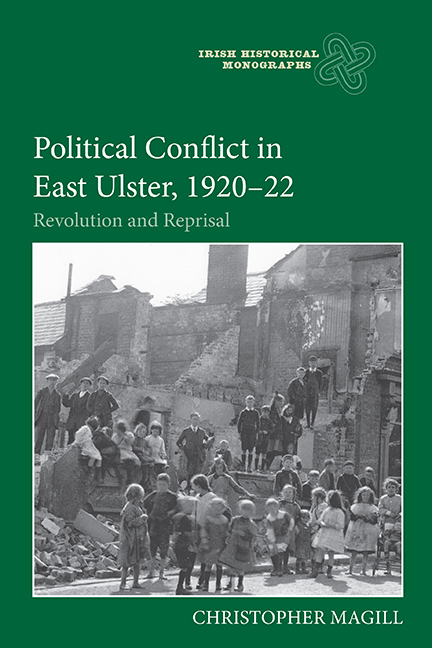Book contents
- Frontmatter
- Dedication
- Contents
- List of Illustrations
- Acknowledgements
- Abbreviations
- A Note on Terminology
- Map
- ‘Cork Justice Travelled a Long Way’: the Assassination of District Inspector Oswald Swanzy
- 1 From Moderates to Militants: the Unionist Community in East Ulster
- 2 Reprisal: the East Ulster Riots
- 3 ‘A Vital But Unenviable Task’: Understanding Loyalist Violence
- 4 A Protestant Force: the Social Composition of the B Specials
- 5 The Wilder the Better? Explaining the Violence of the Ulster Special Constabulary
- 6 A Misunderstood Minority: Irish Nationalists
- Conclusion
- Bibliography
- Index
- Irish Historical Monographs Previous Volumes
‘Cork Justice Travelled a Long Way’: the Assassination of District Inspector Oswald Swanzy
Published online by Cambridge University Press: 21 October 2020
- Frontmatter
- Dedication
- Contents
- List of Illustrations
- Acknowledgements
- Abbreviations
- A Note on Terminology
- Map
- ‘Cork Justice Travelled a Long Way’: the Assassination of District Inspector Oswald Swanzy
- 1 From Moderates to Militants: the Unionist Community in East Ulster
- 2 Reprisal: the East Ulster Riots
- 3 ‘A Vital But Unenviable Task’: Understanding Loyalist Violence
- 4 A Protestant Force: the Social Composition of the B Specials
- 5 The Wilder the Better? Explaining the Violence of the Ulster Special Constabulary
- 6 A Misunderstood Minority: Irish Nationalists
- Conclusion
- Bibliography
- Index
- Irish Historical Monographs Previous Volumes
Summary
I
At 1.00 p.m. on 22 August 1920, District Inspector Oswald Swanzy of the Royal Irish Constabulary (RIC) left Sunday service at Christ Church in Lisburn. He had not lived in the town long, having been transferred there only a few months previously, but he was a respected figure in the unionist-dominated town, known for his previous tenure as a district inspector in Cork city where he led the RIC's fight against the Irish Republican Army (IRA). The Swanzy family name had a modest reputation in parts of Ulster, having bred generations of clergy and lawyers, and Swanzy's father, a solicitor, was the cousin of a renowned eye surgeon, Sir Henry Rosborough. Swanzy's respectability was reflected in the company he kept, none more clearly than Major Gerald Valentine Ewart, an esteemed local war veteran. It was with the major that Swanzy walked towards home on that summer Sunday afternoon, neither of them noticing the four IRA gunmen standing at the corner of Market Square in the centre of the town.
Swanzy had become well known to the republican leadership in Cork city, including the Sinn Féin Lord Mayor Tomás MacCurtain. The revolutionary movement in Cork, as elsewhere, was comprised of political and military factions, often characterised by fraught relations between the two. MacCurtain, the politically minded commandant of Cork's No. 1 Brigade, often acted as a restraint on the worst excesses of IRA violence. On the afternoon of 19 March 1920 District Inspector Swanzy, Divisional Commissioner Clayton and County Inspector Maloney received a military delegation which presented evidence that MacCurtain had been due to take part in an ambush aimed at assassinating Lord French, the Lord Lieutenant of Ireland. The police, however, refused to believe that MacCurtain was anything other than a political republican and the meeting ended without agreement on whether to arrest him. After consulting their informant once again, the military sent a dispatch to an RIC officer, Michael Feeley, restating their belief in MacCurtain's guilt and indicating that they would arrest him that night. Feeley passed the note to the county inspector who ordered that it be taken directly to Swanzy. Not wanting to wake Swanzy, who had returned home to retire early that evening, Feeley left the dispatch on Swanzy's desk in the barracks.
- Type
- Chapter
- Information
- Political Conflict in East Ulster, 1920–22Revolution and Reprisal, pp. 1 - 16Publisher: Boydell & BrewerPrint publication year: 2020

